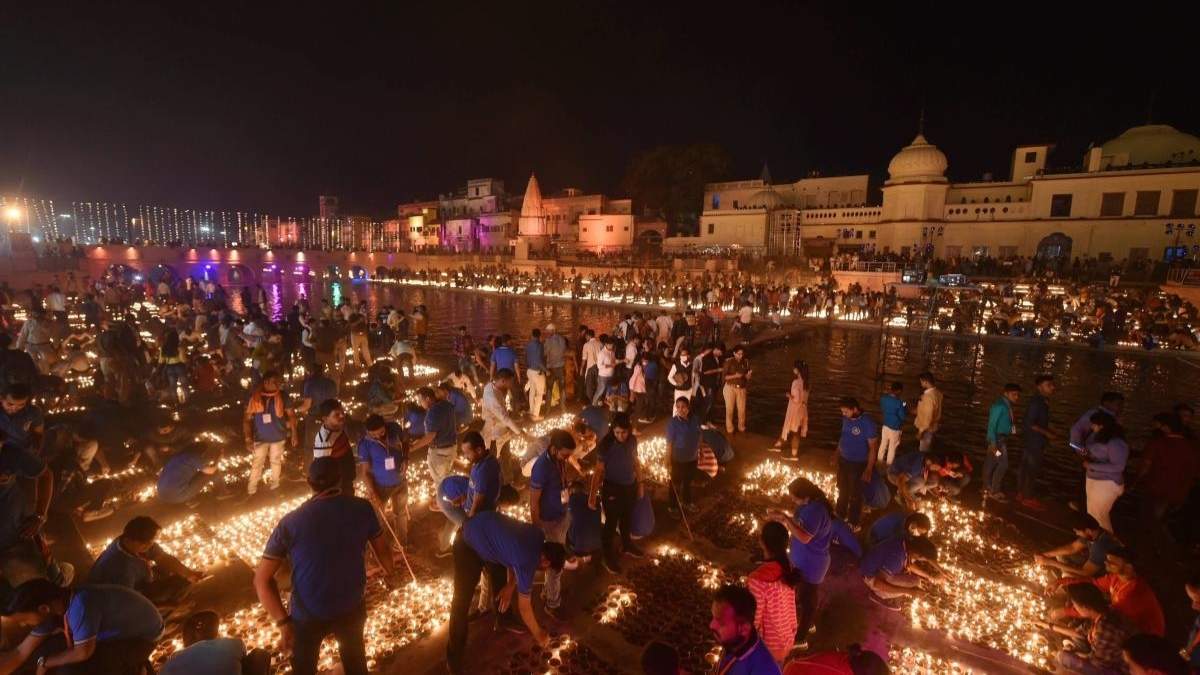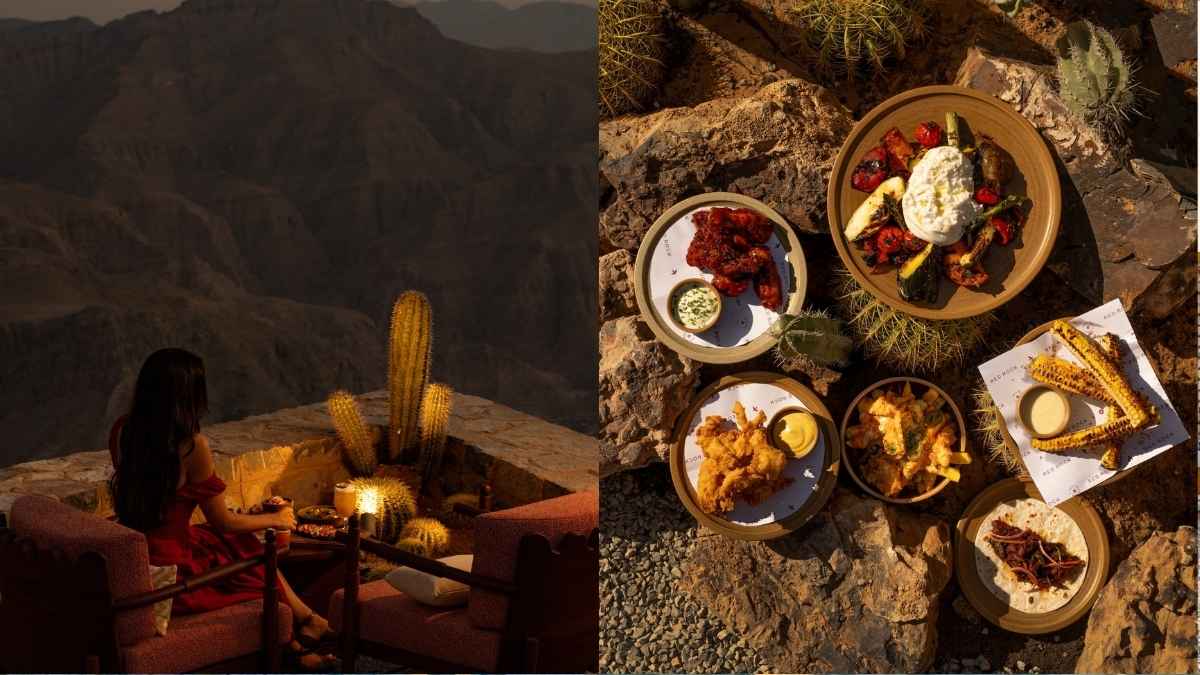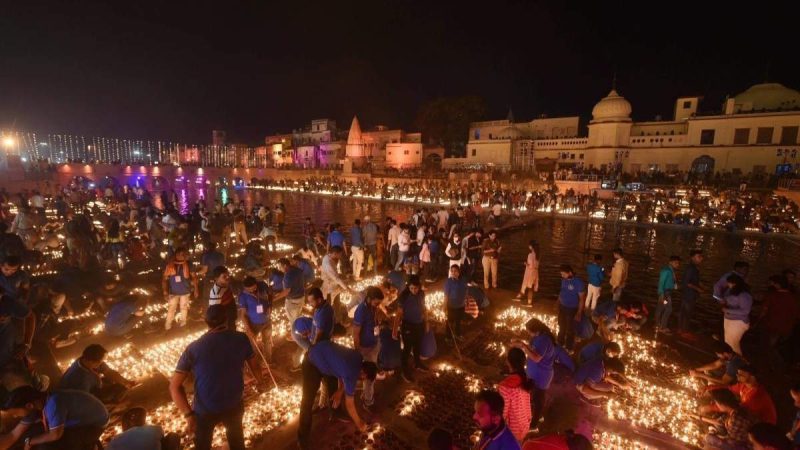Ayodhya on Diwali doesn’t announce itself with banners; it seeps into you through fleeting moments: a marigold draped crookedly across a shop, the sharp tang of ghee frying in a narrow alley, and the quiet, almost conspiratorial anticipation on pilgrims’ faces as the sun rises. By evening, the city shakes off its ordinary self. People flock to the Saryu River, each clutching a tiny clay lamp, faces trembling between devotion, wonder, and the thrill of being part of something centuries old. The lamps shine across the water, turning it into a river of molten gold, and in that chaotic hush, Ayodhya stops being a town; it becomes a story, lived and retold every year, louder and warmer than any firework could ever hope to be.
Why Diwali At Ayodhya Feels Unlike Anywhere Else?
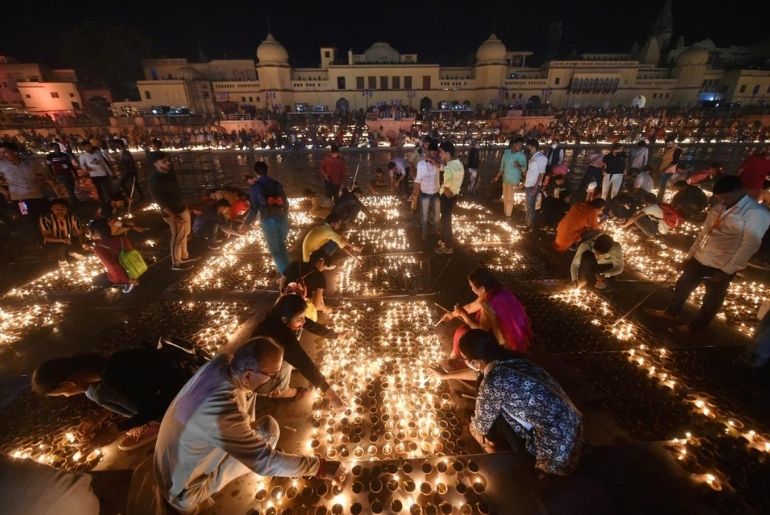
Ram Ki Paidi doesn’t just host the festival, it is the festival itself. Steps crammed with devotees shimmer with lakhs of diyas, the river below reflecting the light as if it had caught fire. Temple chants rise and become a soundtrack of devotion. From the top of Hanuman Garhi, the city looks like a constellation of lights, each lamp holding a story whispered through alleys and homes.
When To Visit: Diwali In Ayodhya
Arriving only on Diwali night shows you the spectacle but not the slow and deliberate heartbeat of the city. That begins days earlier, around October 17 or 18, when Ramayana-themed processions thread through narrow streets and vendors hand out sweets wrapped in newspaper, like little tokens of devotion.
By October 20, every ghat is alive: lamps glinting on steps, temples drenched in marigold and jasmine, and the Saryu waiting to carry the golden glow downstream.
Also Read: Ayodhya’s Ram Temple To Get Ramayana-Themed Wax Museum This Deepotsav; All You Need To Know
Where The Magic Lives: Diwali In Ayodhya
1. Ram Mandir & Ram Ki Paidi
The newly inaugurated Ram Mandir is more than a temple; it’s the gravitational centre of Diwali. Arrive mid-afternoon to claim a spot on the ghats. As the sun slips away, flames flicker and stretch across the water like living veins of light.
2. Hanuman Garhi Temple
Seventy-six steps up, every footfall is worth it. From here, the city is a scatter of lamps, each a tiny, flickering story. Temple bells clash with distant chants, showing a kind of raw harmony no recording could ever capture.
3. Kanak Bhawan & Nageshwar Nath Temple
For those craving a pause amid the hoopla, these temples are quiet oases. Kanak Bhawan’s aartis unfold among flowers, contrasting the luminous chaos below, while Nageshwar Nath lets you watch the festival breathe at its own slow rhythm.
4. Saryu Ghat
This is where Diwali becomes cinematic. Lamps drift downstream, escaping like tiny vessels, and the crowd softens into awe. Conch shells, murmured prayers, and temple bells show a chorus that is unplanned and unscripted.
How To Reach Ayodhya?
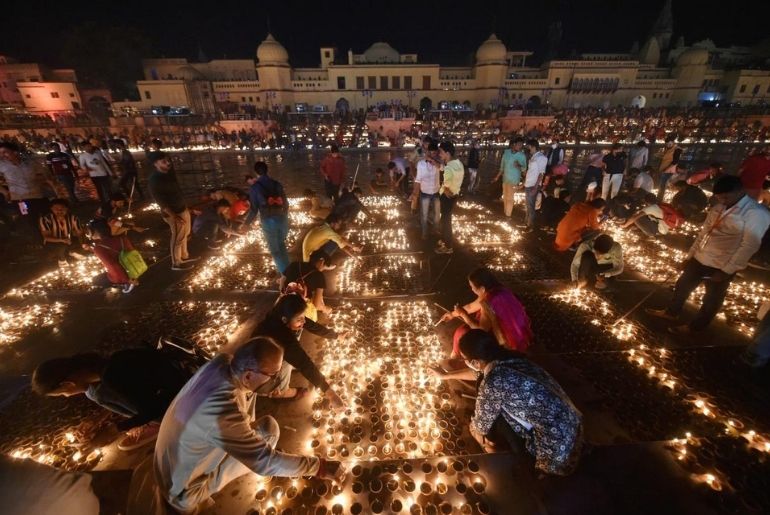
Getting to Ayodhya is like walking into a story already in motion, one you can feel in the air long before you see it. Fly into Maharishi Valmiki International Airport, ten kilometres from the ghats, and a cab will thread through streets alive with pre-Diwali tension for ₹300-₹500, though traffic can slow to a crawl when festival preparations peak.
Trains reach Ayodhya Junction and Cantt from Lucknow, Varanasi, and Delhi; a sleeper from Lucknow costs roughly ₹150, but during Deepotsav, early booking is a survival trick. Roads from Lucknow take around two and a half hours by cab at ₹2,500 or by bus for ₹300-₹600, yet the final stretch is on foot, where narrow lanes, sizzling ghee, and throngs of pilgrims merge into a pulse you can literally feel under your shoes. Walking becomes part of the festival itself, a ritual of arrival before the lights even ignite.
Where To Stay
Rooms vanish like sparks during Diwali. Budget travellers find refuge at Birla Dharamshala or Hanuman Garhi Ashram, ₹600-₹800 a night, barebones, shared bathrooms, but a flood of human voices, prayers, and laughter that lodge in your memory.
Mid-range hotels such as Ramprastha and Panchsheel cost ₹2,000-₹4,000, putting you steps from the ghats’ molten-light rivers. Taj Sarayu Ayodhya starts around ₹15,000, with curated Deepotsav experiences and a vantage point that lets you watch the festival swell below. Homestays near Naya Ghat are intimate, offering glimpses into family rituals that no hotel can simulate, rituals that feel like a secret shared just with you.
Also Read: Good News! Government Directs All Airlines To Maintain Reasonable Airfares Ahead Of Diwali
Eating At Ayodhya In Diwali
Ayodhya tastes of fried ghee, sugar, smoke, and chatter. At Ram Ki Paidi Market, halwais twist jalebis into dizzying spirals, gujiya stacks teeter like golden towers, and samosas vanish the instant they hit your hand. Thaggu ke Ladoo is less like a dessert and more like a pilgrimage in itself.
Ramayana Café and Sarayu View Restaurant serve thalis for ₹200-₹400; they are simple but shining with local personality. When your legs threaten mutiny after roaming the ghats, a ₹20 kulhad of chai by the river becomes a quiet, perfect reward, warming fingers and soul alike.
Budgeting Your Trip
A three-day Deepotsav stay can be tailored to appetite and wallet. Budget travellers manage ₹5,000-₹8,000 for trains, dharamshala lodging, and street eats. Mid-range, ₹12,000-₹18,000 covers flights, hotels, and some guided experiences. Luxury seekers splurge ₹30,000+ for premium stays and specialised events. Temple entry costs nothing, but for prime ghat access, wristbands may be needed from the Tourist Facilitation Centre or local authorities.
Arrive early, dress modestly and comfortably, and carry water, a torch, and a power bank. Mobile signals falter amid throngs, so pre-plan meetups. Buy diyas for ₹20-₹50 and release them onto the Saryu; small actions here feel monumental, grounding you amid the human surge of devotion.
Also Read: Goa’s Dongri Village Has a 200-Year-Old Diwali Toran Tradition You Might Have Never Heard Of
When diyas drift downstream and chants ride the river breeze, Ayodhya reveals why Deepotsav is unlike any Diwali elsewhere. This isn’t a spectacle you stand outside to watch, it’s one you step into, sink into, and let wrap around your body and spirit. Faith, light, and memory tangle together, and long after the last lamp dies, their glow clings to you, luminous and stubborn.
Cover Image Courtesy: AllIndiaRadio/X
For more such snackable content, interesting discoveries and the latest updates on food, travel and experiences in your city, download the Curly Tales App. Download HERE. First Published: October 13, 2025 11:08 PM
